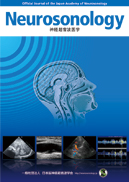巻号一覧

30 巻 (2017)
- 3 号 p. 117-
- 2 号 p. 35-
- 1 号 p. 1-
30 巻, 1 号
選択された号の論文の5件中1~5を表示しています
- |<
- <
- 1
- >
- >|
目で見る神経超音波診断
-
貞廣 浩和, 野村 貞宏, 鈴木 倫保2017 年 30 巻 1 号 p. 1-3
発行日: 2017年
公開日: 2017/07/12
ジャーナル フリーPDF形式でダウンロード (1566K)
原著論文
-
澤口 能一, 王 作軍, 伊藤 創馬, 菊池 蘭, 山本 博之, 立花 研, 中島 孝則, 中田 典生2017 年 30 巻 1 号 p. 4-7
発行日: 2017年
公開日: 2017/07/12
ジャーナル フリーBackground: Reocclusion occurred after various recanalization therapies. In particular, reocclusion was frequently observed immediately after the recombinant tissue-type plasminogen activator (rt-PA) treatment. This is a fatal problem, because anticoagulant therapy is prohibited within 24 hours after the rt-PA treatment. We report the thrombus growth control effect of non-invasive ultrasound (US) in an in vitro clot growth model.
Method: A clot was prepared by incubation of citrated human plasma, CaCl2 solution and thrombin at 37°C for 60 min in a latex tube. After incubation, the latex tube was filled with degassed citrated human plasma. The plasma around the clot was irradiated with US in a water bath at 37°C. The US irradiation condition was: transducer size 10 mm, frequency 500 kHz, continuous wave, average intensity 0.32 W/cm2, 30 min. To evaluate the thrombus growth control effect, the clot’s weight was measured before and after US irradiation.
Results: The clot’s increased weight was significantly suppressed in the US group compared with the Non-US group (58.3 mg vs. 107.7 mg, p<0.0025).
Conclusions: In this study, we showed that the non-invasive US could control the growth of thrombus. This safe and simple US method may be used to prevent the reocclusion after recanalization therapy.抄録全体を表示PDF形式でダウンロード (850K) -
五十嵐 晴紀, 岡部 龍太, 岡村 穏, 竹川 英宏, 鈴木 圭輔, 飯塚 賢太郎, 塚原 由佳, 西平 崇人, 鈴木 綾乃, 岩崎 晶夫, ...2017 年 30 巻 1 号 p. 8-12
発行日: 2017年
公開日: 2017/07/12
ジャーナル フリーObjective: The jet flow direction at the stenotic lesion is not always parallel to the blood vessel direction. Therefore, we examined the optimal angle correction.
Methods: Among 50 subjects with stenosis at the internal carotid artery (ICA) bifurcation who underwent carotid ultrasonography and digital subtraction angiography (DSA). The measurement of peak systolic velocity (PSV) at the stenotic lesion site was performed according to the guideline of Japan Academy of Neurosonology. The subjects were divided into 2 groups: group A, angle was aligned parallel to the blood flow at the stenotic lesion (n = 23) and group B, angle was aligned parallel to the blood vessel (n = 30). ICA stenosis was diagnosed on DSA images according to NASCET criteria.
Results: In groups A and B, there was a significant correlation between PSV and stenosis ratio. In diagnosing ICA stenosis (≥ 70%), the area under ROC curve, the sensitivity and specificity of PSV were 0.973, 100% and 85.7% with a cutoff level of 203.5 cm/s and 0.765, 70.0% and 80.0% with a cutoff level 256.9 cm/s, respectively.
Conclusion: Our study suggests the angle-adjustment towards the blood flow at the stenotic lesion site is superior to the angle-adjustment parallel to the blood vessel for PSV measurement.抄録全体を表示PDF形式でダウンロード (854K)
症例報告
-
安原 由子, 谷岡 哲也, 高瀬 憲作, 趙 岳人, 元木 一志, 阿瀬川 孝治2017 年 30 巻 1 号 p. 13-17
発行日: 2017年
公開日: 2017/07/12
ジャーナル フリーOur previous study evaluated the B-mode findings of the muscle infiltrated with second generation long acting injectable antipsychotics (SG-LAIs). SG-LAIs were seen as a high-echogenicity mass with marked acoustic shadowing in the gluteus medius muscle. The aim of this study was to examine the echogenicities of the muscle with SG-LAI. This study demonstrated 3 patients with schizophrenia under treatment with risperidone (RLAI), paliperidone (PLAI) and aripiprazole (ALAI) (one case each). Quantitative diagnostic ultrasound imaging has been proposed as a method of estimating muscle quality using echogenicities. Grayscale histogram analysis of Photoshop Premiere Elements 14.0 was used to determine the muscle tissue echogenicity in a region of interest (ROI). The pre- and post-injected SG-LAI echogenicities were analyzed using a paired t-test with a significance level of 5%. Each SG-LAIs could be illustrated as high echogenic masses with acoustic shadowing. The corresponding grayscale histogram values of selected ROI in the injected muscles were significantly increased in all cases. It was considered that the diffusion states of SG-LAIs by ultrasonography were important time course evaluations providing objective evidence.抄録全体を表示PDF形式でダウンロード (702K)
短報
-
永井 秀政, 辻 将大, 江田 大武, 中川 史生, 神原 瑞樹, 吉金 努, 萩原 伸哉, 中右 博也, 宮嵜 健史, 秋山 恭彦2017 年 30 巻 1 号 p. 18-22
発行日: 2017年
公開日: 2017/07/12
ジャーナル フリーIntroduction: Proximal stenosis of the subclavian artery (SCA) shows progression to subclavian steal syndrome (SSS)/phenomenon (SSP), characterized by retrograde flow in the ipsilateral vertebral artery (VA). Here we describe the clinical manifestations and ultrasound findings of ipsilateral VA in patients with high-grade stenosis of the SCA, and the role of VA ultrasound in percutaneous transluminal angioplasty (PTA) stenting of the SCA.
Patients: Twelve patients (male: 10, female: 2; age: 17–86 yr) were selected from among inpatients with SCA stenosis treated in our department between 2009 and 2015.
Results: The affected vessel was the left in 8 cases and the right in 4. The causes of stenosis were atherosclerosis in 10 cases, congenital in 1, and arteritis in 1. The symptoms were dizziness, faintness, syncope, diplopia, dysarthria, rest pain, coldness and arm claudication on effort. The cases were divided into SSS (n=7), SSP (n=2), and SCA stenosis only (n=3). The Doppler flow patterns were classified as normal antegrade (n=3), bunny waveform (n=0), alternating (n=6), reverse (n=2), and not detected (n=1). Ten of the patients underwent PTA stenting and 2 conservative therapy.
Conclusions: Alternating and reverse flow patterns in the VA might lead to the surgical indication for PTA-stenting of SCA.抄録全体を表示PDF形式でダウンロード (895K)
- |<
- <
- 1
- >
- >|